Research Lab: Monjardez
Dr. Geraldine Monjardez joined the Department of Forensic Science at Sam Houston State University (SHSU) as an Assistant Professor of Forensic Science in August 2019.
In 2012, Dr. Monjardez completed a PhD in Chemical Engineering and Analytical Science (biomedical spectroscopy) at the University of Manchester in the United Kingdom, investigating the feasibility of feasibility of Fourier Transform Infrared imaging spectroscopy in discriminating benign prostatic hyperplasia from Prostate cancer in blood serum samples. She developed a protocol demonstrating its high potential as a tool in the analysis of prostate cancer blood serum samples, in collaboration with the genito-urinary cancer group at the Paterson Institute for Cancer Research in Manchester, UK.
Before joining SHSU, she worked as a postdoctoral research associate for the University of Wisconsin-Milwaukee, where she ran experiments using both the synchrotron and the Globar Infrared light sources at the IRENI (Infrared Environmental Imaging) beamline at the Synchrotron Radiation Centre in Stoughton, WI. She then served as a postdoctoral research scientist from 2016-2018 at Western Carolina University, where she investigated the development of SERS (Surface Enhanced Raman Spectroscopy)-active forensic evidence swabs for rapid, non-destructive confirmatory serological screening and STR (Short Tandem Repeat) typing of human remains.
Dr. Monjardez is an associate member of the American Academy of Forensic Sciences (AAFS), and a member of the American Society of Trace Evidence Examiners (ASTEE), the American Chemical Society (ACS) and Texas Society for Microscopy (TSM).
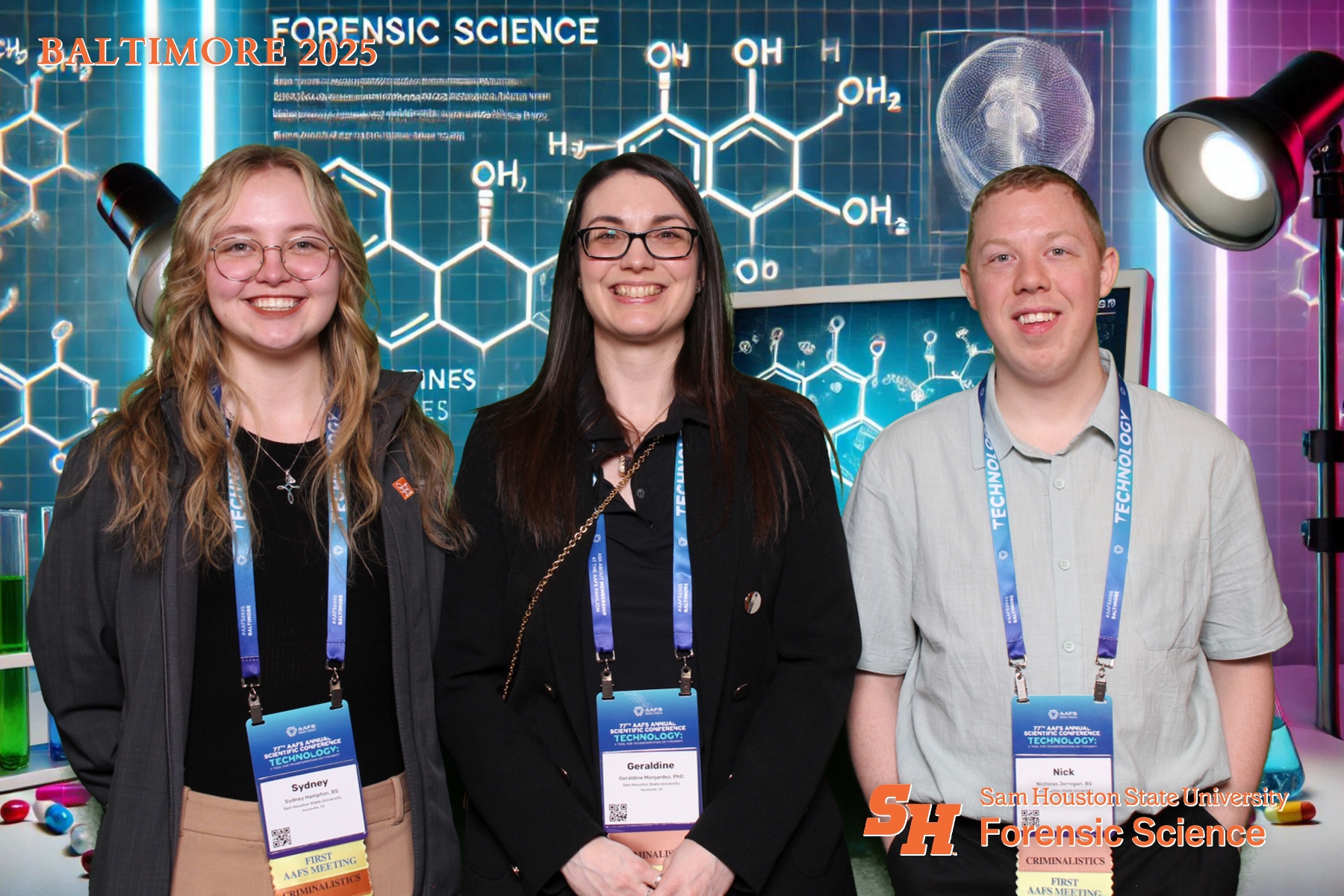
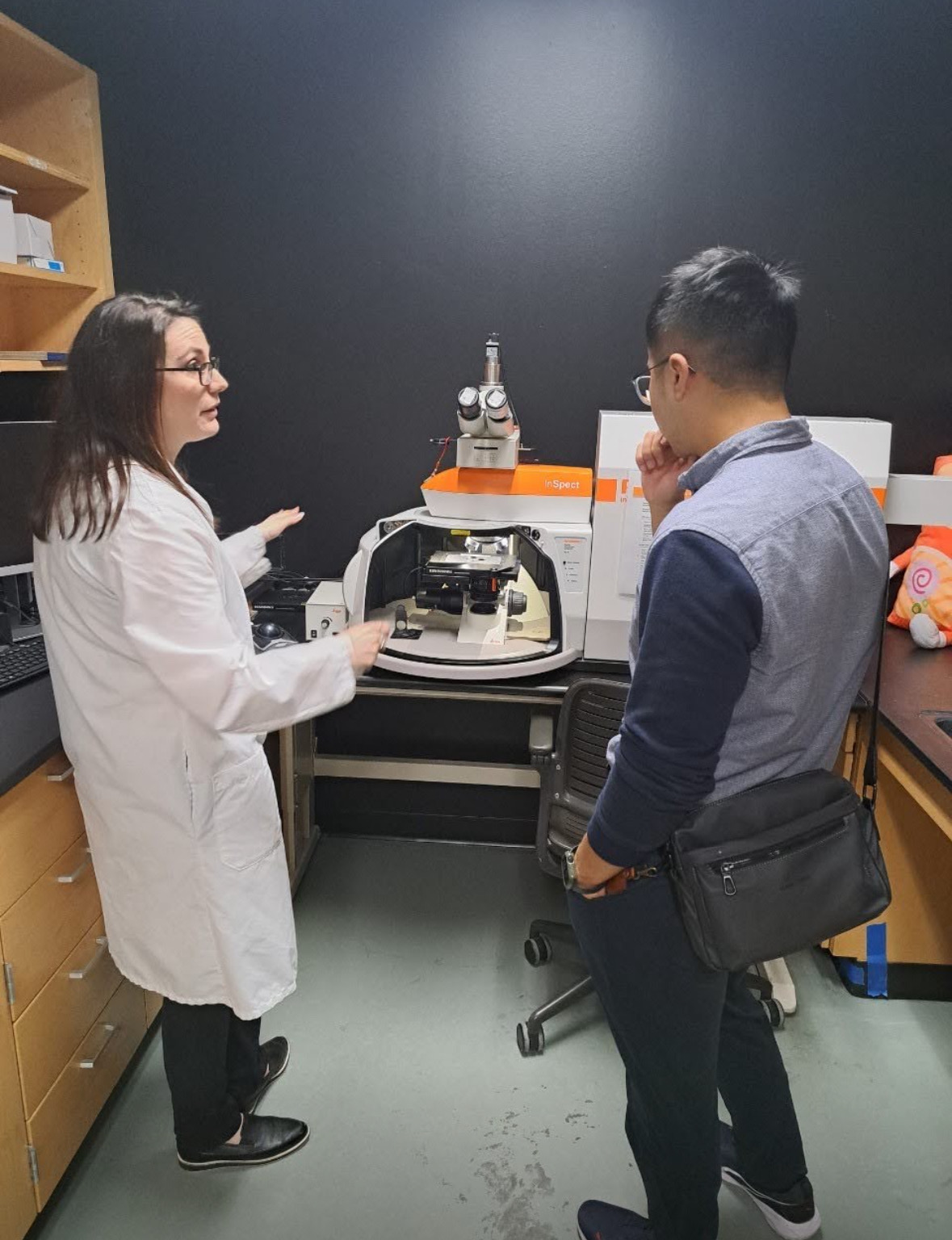

Research Interests
At SHSU Dr. Monjardez continues to merge her research interests applying spectroscopic techniques, including Fourier Transform infrared (FTIR) spectroscopy, Raman spectroscopy and surface enhanced Raman spectroscopy (SERS) to the fields of trace evidence and forensic chemistry.
Her research in forensic chemistry focuses on the trace chemical analysis of forensic samples, including body fluids, post-blast explosive residues and seized drugs.
Dr. Monjardez's research goals also include the development of SERS-active substrates (application of nanomaterials) to obtain accurate and reproducible spectral information for field detection.
Her current research in trace evidence involves assessing the evidential value of vehicular fluids, such as transmission fluids, brake fluids and lubricating greases for investigative purposes using multiple instrumental techniques, including Scanning electron microscopy coupled with energy dispersive x-ray spectroscopy (SEM-EDS).
Other current research interests include the field detection of chemical contaminants in food and biological matrices.
Research Updates
-
Jay Laetsch III publishes in Forensic Science International
March 2025
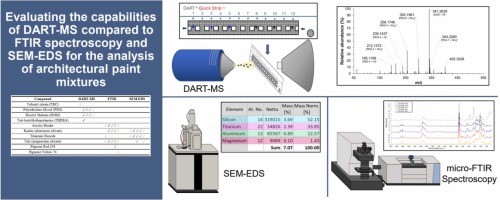
Graduated master student Jay Laetsch III published his capstone findings in Forensic Science International. The publication is titled “Evaluating the capabilities of DART-MS compared to FTIR spectroscopy and SEM-EDS for the analysis of architectural paint mixtures”. Jay’s capstone aimed to evaluate the effectiveness of DART-MS compared to FTIR spectroscopy and SEM-EDS for the analysis of architectural paint analysis, as well as investigate how DART-MS could be incorporated into a paint analysis workflow. This article highlighted that the compounds detected through DART-MS analysis were not found with either FTIR or SEM-EDS, demonstrating the complementary nature of these techniques. Furthermore, DART-MS was able to identify and monitor ions specific to the black base paint within mixed paint samples, supporting the adoption of a combined approach for enhanced architectural paint discrimination.
Available via DOI: https://doi.org/10.1016/j.forsciint.2025.112405.
-
Interview with Spectroscopy
February 2025

I was interviewed by Spectroscopy, alongside my two coauthors, Dr. Christopher Zall and Dr. Jared Estevanes, to discuss our recent study, which examined the crystal structure of ammonium nitrate (AN) following exposure to explosive events.
The published interview can be accessed via the following link: Investigating ANFO Lattice Vibrations After Detonation with Raman and XRD
-
Nicholas Jernigan presents at the 77th annual AAFS meeting in Baltimore, MD
February 2025
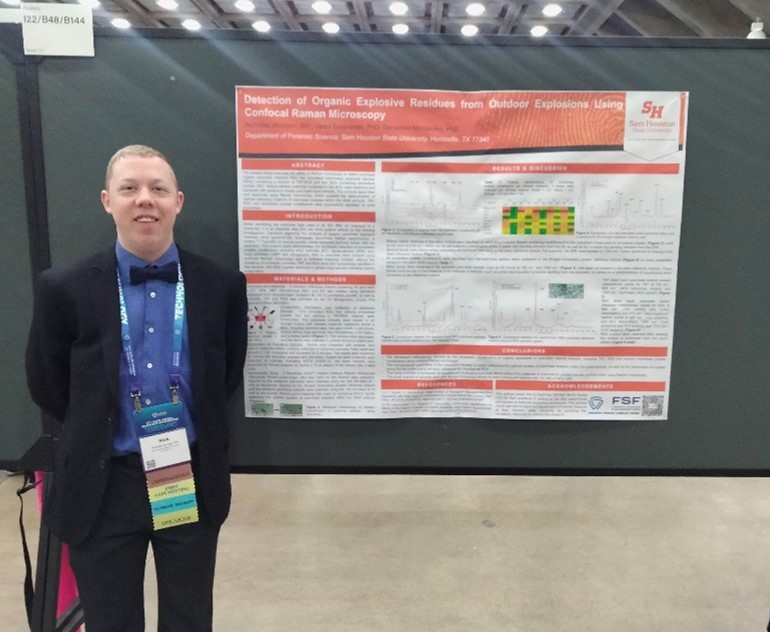
Congratulations to Master student, Nicholas Jernigan, for his poster presentation at the 77th annual AAFS meeting in Baltimore, MD. The poster presentation covers research conducted in Dr. Monjardez’s research lab on the detection of organic explosives residues using micro-Raman spectroscopy. His poster can be accessed here.
-
Sydney Hampton presents at the 77th annual AAFS meeting in Baltimore, MD
February 2025
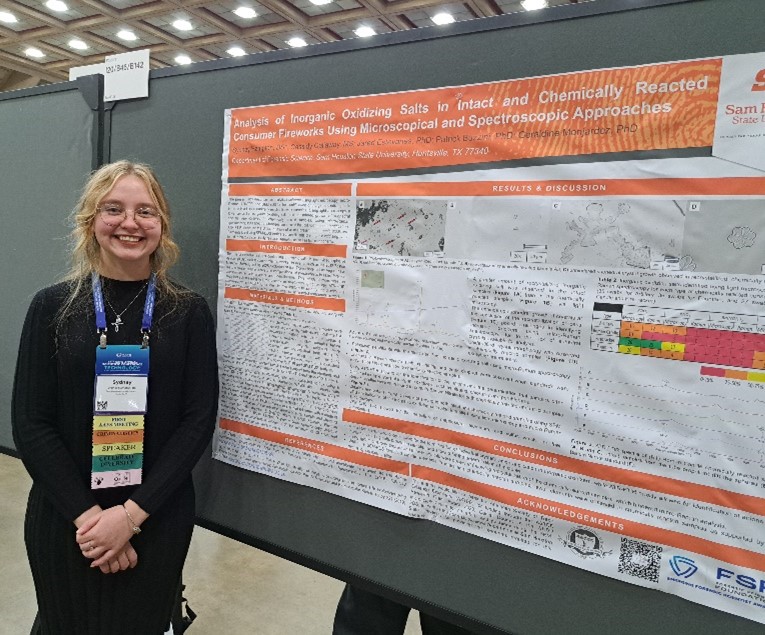
Congratulations to Master student, Sydney Hampton, for her poster presentation at the 77th annual AAFS meeting in Baltimore, MD. The poster presentation covers research conducted in Dr. Monjardez’s research lab on the detection of inorganic oxidizing salts in intact and chemically reacted consumer fireworks using various analytical techniques common in forensic laboratories, such as light microscopy, micro-Raman spectroscopy, ATR-FTIR and SEM-EDS. Her poster can be accessed here.
-
Dr. Monjardez presents at the 2024 Texas Fire Marshals Conference
November 2024
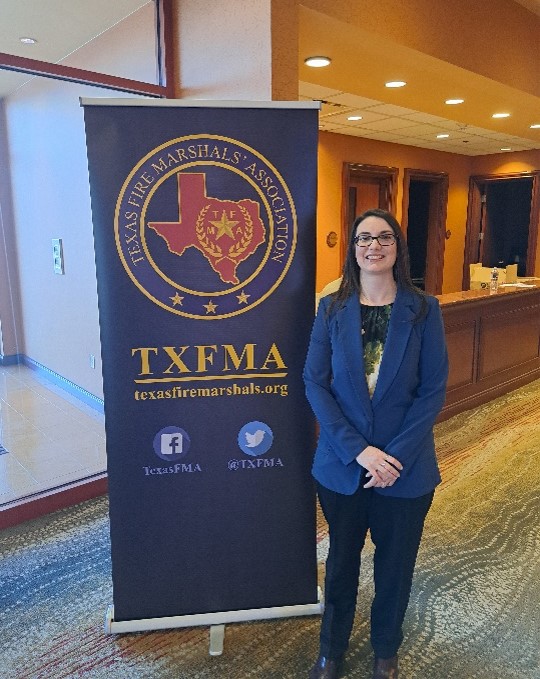
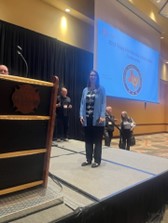
On November 5, 2024, Dr. Monjardez presented at the 2024 Texas Fire Marshals Conference in San Marcos, TX, on two explosives research projects conducted in the Monjardez research group. The first one had for goal to better understand the detection capabilities of two types of portable instruments relative to their traditional benchtop counterparts commonly found in forensic laboratories to detect and identify intact explosives. The objective for the second project was to develop and utilize novel sample preparations/introductions for a variety of spectroscopic and mass spectrometry approaches to detect and identify trace explosives residue, while assessing their benefits and limitations.
-
Dr. Jared Estevanes publishes in Forensic Science International (FSI)
November 2024
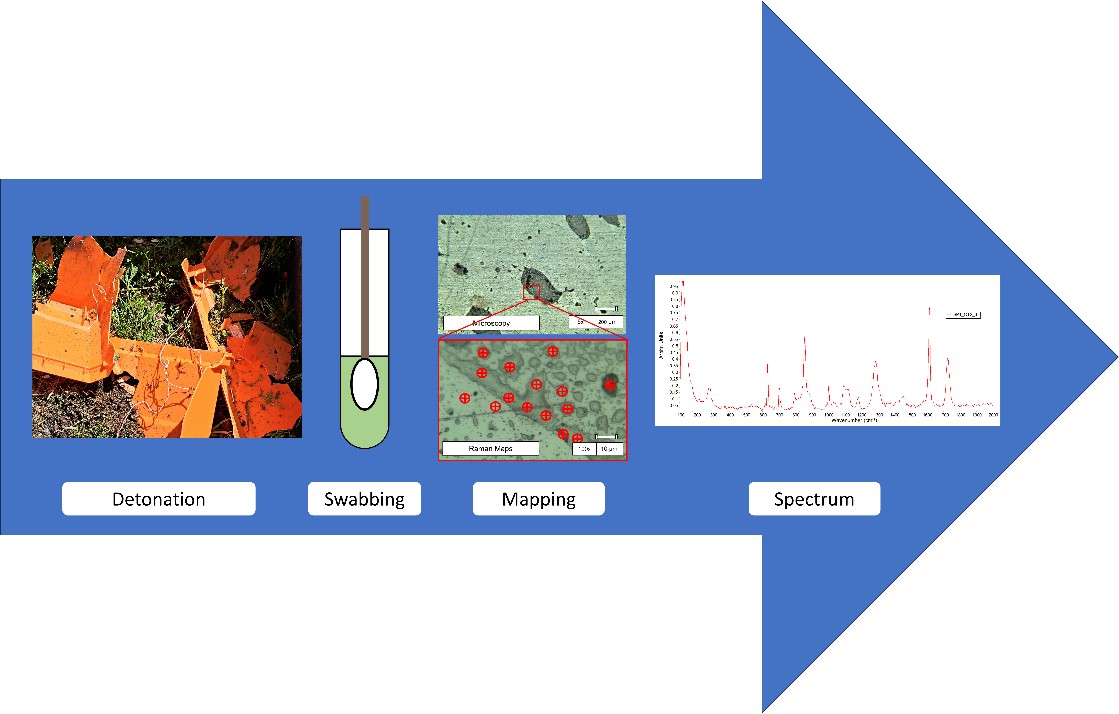
This manuscript describes a workflow involving a simple liquid extraction for the rapid and accurate identification of smokeless powder constituents, TNT, and RDX post-blast explosives residue using confocal Raman microscopy following authentic explosive events.
The methodology developed here provides a practical application of ASTM E3329–21 Standard Practice for Establishing an Examination Scheme for Explosive Residues, demonstrating the successful identification of organic explosives in dried post-blast residue extracts using confocal Raman microscopy. This study also provides a framework for practitioners when evaluating post-blast debris without the presence of unburned or partially burned particles when using Raman microscopy.
The paper is available at DOI: https://doi.org/10.1016/j.forsciint.2024.112292
-
Dr. Jared Estevanes and Nicholas Jernigan publish in Journal of Raman Spectroscopy
October 2024
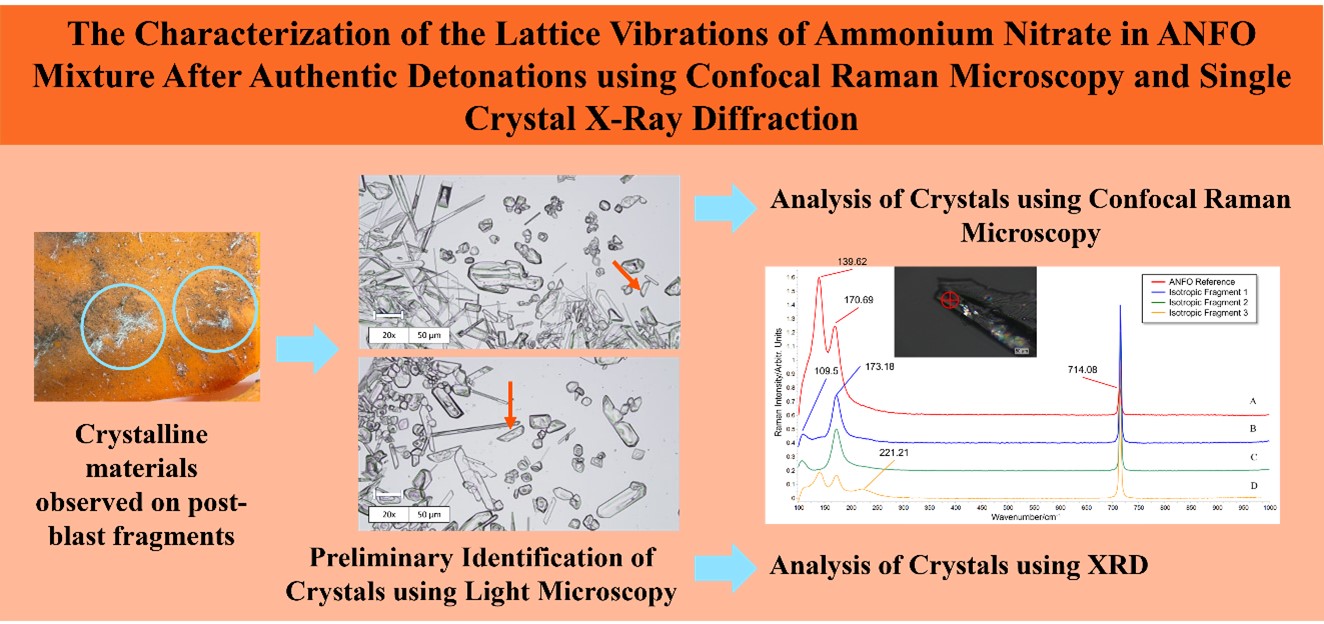
This manuscript describes the characterization of ammonium nitrate lattice vibrations in an ammonium nitrate and fuel oil mixture (ANFO) following authentic explosive events using confocal Raman microscopy and single-crystal X-ray diffraction (XRD). This research was a collaboration between Dr. Monjardez and Dr. Christopher Zall of the Chemistry department at SHSU.
The combination of the crystalline properties obtained with microscopy and the spectral information provided by Raman spectroscopy and XRD was vital in identifying the structural state of the ammonium nitrate crystals. While the 400–1700 cm−1 region of the Raman spectrum is traditionally exploited for analyses of inorganic oxidizers, such as ammonium nitrate, this study demonstrates the importance of low frequency Raman spectroscopy (10-250 cm-1), which allows the identification of distinct spectral features of these crystalline salts.
The paper is available at DOI: https://doi.org/10.1002/jrs.6752.
-
Jose Grijalva publishes in Talanta Open (Special issue on Analytical Developments for the Quality and Safety Control of Cannabis Products)
June 2024
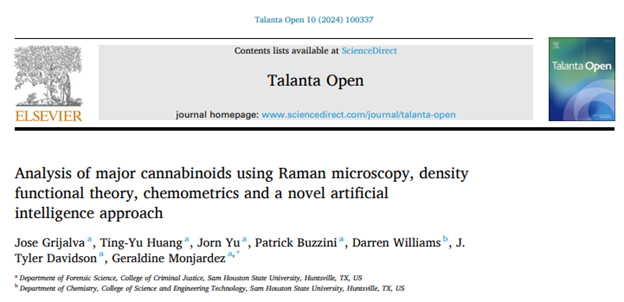
The findings of graduated master student Jose Grijalva’s capstone and the research conducted by graduated PhD student Dr. Ting-Yu Huang have been published in Talanta Open. The publication is titled “Analysis of major cannabinoids using Raman microscopy, density functional theory, chemometrics and a novel artificial intelligence approach”. The research highlighted in this paper was in collaboration between Dr. Monjardez, Dr. Davidson, Dr. Buzzini, and Dr. Yu of the Forensic Science department and Dr. Williams of the Chemistry department at SHSU.
The study aimed to exploit the capability of Raman microscopy to collect high-resolution spectra of seven cannabinoid analytical standards, followed by their reliable differentiation using both traditional chemometric approaches, namely principal component analysis (PCA) and linear discriminant analysis (LDA), respectively, and a novel artificial intelligence (AI) approach, in addition to the comparison of the experimental Raman spectra of Δ9-THC, CBD, and CBC to simulated spectra from DFT calculations to better understand their molecular vibrations.
Available via DOI: https://doi.org/10.1016/j.talo.2024.100337.
-
Dr. Jared Estevanes manuscript accepted for publication in The Microscope
May 2024
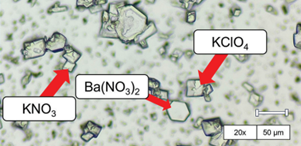

Congratulations to graduated PhD student Jared Estevanes for his manuscript being accepted for publication in The Microscope.
The publication is titled “Forensic Analysis of Recrystallized Inorganic Oxidizing Salts Used in Pyrotechnic-Based Improvised Explosive Devices Using Light Microscopy and Micro-Raman Spectroscopy”. This research was a collaboration between Dr. Monjardez and Dr. Buzzini and focused on evaluating the advantages and challenges of analyzing post-blast pyrotechnic pipe bombs using a combination of light microscopy and micro-Raman spectroscopy.
This research aimed to determine whether the inorganic oxidizing salts present in consumer fireworks can be recrystallized in deionized water and identified using techniques already available in forensic laboratories, namely polarized light microscopy (PLM) and micro-Raman spectroscopy, in both intact samples and their explosive residues collected after an explosion.
-
Dr. Jared Estevanes publishes in Forensic Chemistry
May 2024
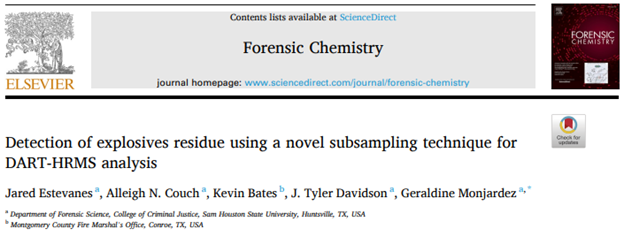
Congratulations to Dr. Jared Estevanes for his publication in Forensic Chemistry.
The publication is titled “Detection of explosives reside using a novel subsampling technique for DART-HRMS analysis”. This research was a collaboration between graduated PhD student Jared Estevanes, Dr. Monjardez, Dr. Davidson, and Alleigh N. Couch of the forensic science department at SHSU and Kevin Bates of Montgomery County Fire Marshal’s office. This study aims to expand the current research on the detection of post-blast organic explosive residues, including TNT, RDX, and smokeless powder components such as diphenylamine, ethyl centralite, methyl centralite, and 2,4-DNT, using DART-MS analysis.
This research focused on the application of a novel sub-sampling technique to filter out particulates from the post-blast debris that could potentially be detrimental to the instrument, while enabling a rapid and reliable analysis of explosive residues recovered from various materials.
Available via DOI: https://doi.org/10.1016/j.forc.2024.100585.
-
Dr. Jared Estevanes graduates with his PhD in Forensic Science, and Cailin Herl and John Laetsch III graduate with their Master of Science in Forensic Science
May 2024
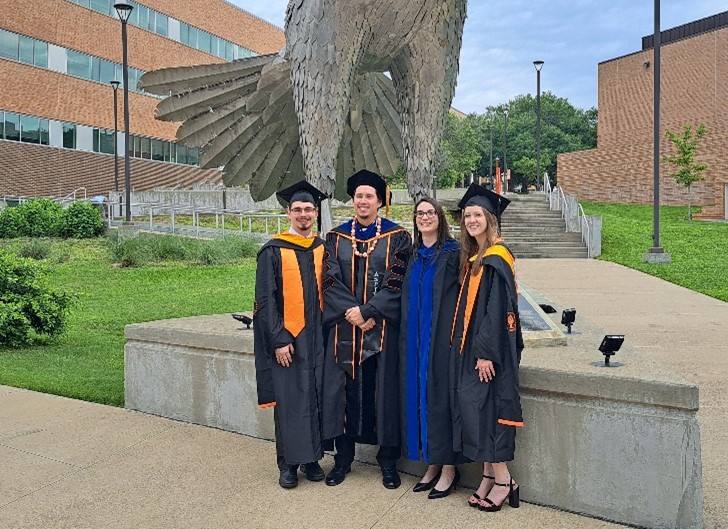
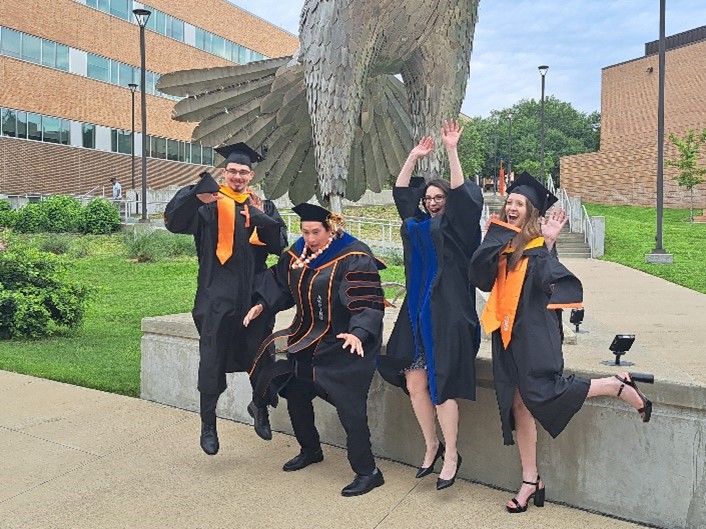
Congratulations to my PhD student Jared Estevanes who graduated with his PhD in Forensic Science and my two master’s students, Cailin Herl and John Laetsch III, who graduated with their Master of Science in Forensic Science.
-
Cailin Herl and John Laetsch III Defend Master’s Capstone
April 2024

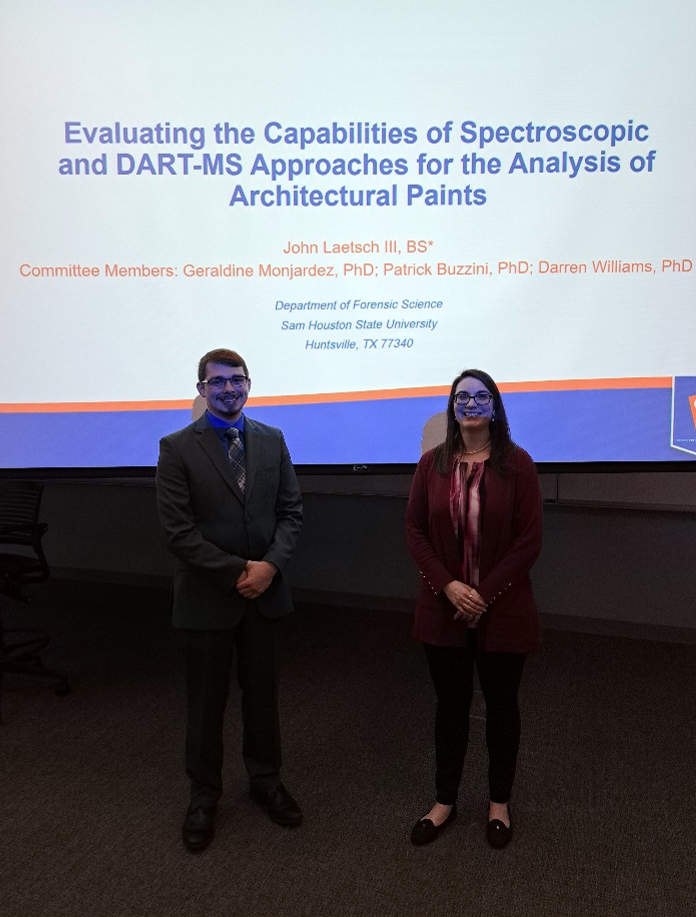
Congratulations to Cailin Herl and Jay Laestch who successfully defended their capstone research.
-
Dr. Jared Estevanes Successfully Defends Dissertation
March 2024
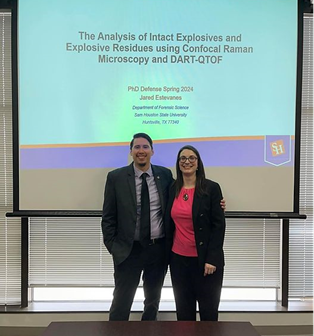
Congratulations to Dr. Jared Estevanes for the successful defense of his dissertation, titled “The Analysis of Intact Explosives and Explosive Residues Using Confocal Raman Microscopy and DART-QTOF”.
-
Dr. Monjardez's Students Present at AAFS 2024
February 2024

Masters student Jay Laetsch presents a poster entitled "Analysis of Major Cannabinoids using Raman Microscopy, Chemometrics, and a Novel Artificial Intelligence Approach." PhD student Jared Estevanes presents an oral presentation entitled "Investigating the Capability of DART®-MS for the Analysis of Common Homemade Explosives."
-
Jared Estevanes publishes in Forensic Chemistry
February 2024

The publication is titled “Investigating the Combined Capability of Confocal Raman Microscopy and DART-MS for the Analysis of Intact Explosives”. This research was a collaboration between Dr. Monjardez and Dr. Davidson, and focused on exploiting the capabilities of each instrument, as well as assessing their limitations to provide a rapid and reliable approach to identify a wide range of intact common explosive compounds. The study also has additional aim of being a foundational work for future post-blast analysis. Available via DOI: https://doi.org/10.1016/j.forc.2023.100502.
-
Cailin Herl presents at the Current Trends in Seized Drug Analysis Symposium - Online Forensic Symposium
February 2024

Congratulations to Master student, Cailin Herl, for her poster presentation at the Current Trends in Seized Drug Analysis Symposium - Online Forensic Symposium, organized by The Center for Forensic Science Research and Education (CFSRE). Her poster is titled “Investigating the Degradation of Benzodiazepines.”
-
Jared Estevanes is awarded the 2023 Research Grant Award from the American Society of Trace Evidence Examiners (ASTEE)
August 2023

Congratulations to Jared! His research proposal has been selected for funding by ASTEE for their 2023 Research Grant Award, which was created to promote research to advance the field of Trace Evidence. This project will investigate 1) whether the inorganic oxidizing salts present in pyrotechnics can be recrystallized in DI water and identified using light microscopy (brightfield and PLM) in the undetonated and detonated samples and 2) whether the combined approach of confocal Raman microscopy and ATR-FTIR spectroscopy can provide more discrimination to identify the components of the pyrotechnics used in homemade explosives.
-
Makenzie Kuehn publishes in Forensic Science International
October 2023

Graduated master student Makenzie Kuehn published her capstone findings in Forensic Science International. The publication is titled “Evaluation of Handheld Raman Spectrometers for the Detection of Intact Explosives”. Makenzie’s capstone was a collaboration between Dr. Monjardez, Dr. Davidson and Kevin Bates, the Assistant Fire Marshal over the Investigation Division for Montgomery County Fire Marshal’s Office, that looked at evaluating portable instrumentation for the detection of intact explosives. This paper highlighted how important identifying the detection capabilities of these handheld instruments are to help guide investigators on how to best utilize them in the field. Available via DOI: https://doi.org/10.1016/j.forsciint.2023.111875.
-
Jared Estevanes is awarded the 2023 Research Grant Award from the American Society of Trace Evidence Examiners (ASTEE)
August 2023

Congratulations to Jared! His research proposal has been selected for funding by ASTEE for their 2023 Research Grant Award, which was created to promote research to advance the field of Trace Evidence. This project will investigate 1) whether the inorganic oxidizing salts present in pyrotechnics can be recrystallized in DI water and identified using light microscopy (brightfield and PLM) in the undetonated and detonated samples and 2) whether the combined approach of confocal Raman microscopy and ATR-FTIR spectroscopy can provide more discrimination to identify the components of the pyrotechnics used in homemade explosives.
-
Makenzie Kuehn and Jose Grijalva graduate with their Master of Science in Forensic Science
May 2023

Congratulations to my two master’s students, Makenzie Kuehn and Jose Grijalva, who graduated with their Master of Science in Forensic Science.
-
Makenzie Kuehn and Jose Grijalva Defend Master's Capstone
April 2023


Congratulations to Makenzie Kuehn and Jose Grijalva who successfully defended their capstone research.
-
PhD Student Jared Estevanes publishes in Forensic Chemistry
April 2023

Congratulations Jared Estevanes for his first author publication Forensic Chemistry. The article is titled “Forensic characterization and differentiation of automotive lubricating greases using Fourier Transform Infrared spectroscopy and Scanning Electron Microscopy-Energy Dispersive X-Ray Spectroscopy”. This study was a collaboration between Dr. Monjardez and Dr. Buzzini that looked at characterizing and differentiating automotive greases using FTIR and SEM-EDS. Initial microscopical assessment showed the presence of three types of particles, which were identified and subsequently labeled as opaque, isotropic, and anisotropic. This study also found that ATR-FTIR spectroscopy highlighted the presence of minor infrared absorption bands that were useful to the differentiation of different grease samples and the elemental analysis with the SEM-EDS identified the opaque particles as solid lubricant additives, containing various amounts of molybdenum and niobium. Available via DOI: https://doi.org/10.1016/j.forc.2023.100502.
-
Jared Estevanes presents his research on lubricating automotive greases at the Texas Society for Microscopy (TSM) 2023 Annual Meeting
March 2023


Congratulations to my PhD student, Jared Estevanes, for his first oral presentation at the Texas Society for Microscopy (TSM) meeting in Dallas, TX. Jared presented his research on lubricating automotive greases titled “Characterization of microscopic particles dispersed in lubricating automotive greases using scanning electron microscopy and energy dispersive x-ray spectroscopy”.
-
Makenzie Kuehn presents at the 75th AAFS annual meeting
February 2023


Congratulations to Master student, Makenzie Kuehn, for her poster presentation at the 75th meeting of the American Academy of Forensic Sciences (AAFS) in Orlando, FL. Her poster is titled “Assessment of Field-Portable Instrumentation for Pre-Blast Explosives Detection.”
-
Erin Bruner's manuscript accepted for the Journal of Raman Spectroscopy
December 2022

This manuscript provides the first forensic application of biosynthesized SERS swabs developed in the Monjardez Lab. SERS is becoming a more popular technique in the forensic science discipline due to its advantages of being rapid and its applicability to field detection. This manuscript demonstrates the efficiency of the biosynthesis to grow nanoparticles on the swabs and shows their viability to be used as SERS substrates to collect and identify animal blood. Available via DOI: 10.1002/jrs.6479.
-
Kevin Bates, Assistant Fire Marshal over the Investigation Division for the Montgomery County Fire Marshal’s Office, and Alex Guerrero, Explosives Enforcement Officer at ATF, visit first year graduate students in the Forensic Science Program
November 2022

-
Recipient of a Forensic Sciences Foundation Lucas Research Grant Program 2022-2023: Jared Estevanes
October 2022
Congratulations to Jared! His research proposal “Investigating the capability of DART-QTOF for the analysis of common homemade explosives” has been selected for funding by the Forensic Sciences Foundation Lucas Research Grant Program for 2022-2023.
-
Capstone Project (2022-2023): Assessment of Field-Portable Instrumentation for Pre-Blast Explosives Detection (Makenzie Kuehn)
September 2022

This project focuses on the assessment of field-portable Raman and GC-MS for the detection of pre-blast explosives such as ammonium nitrate fuel oil (ANFO), nitromethane, 2,4,6-trinitrotoluene (TNT), and smokeless powders in relation to their benchtop counterparts. It was developed in collaboration with Kevin Bates, Assistant Fire Marshal at the Montgomery County Fire Marshal’s Office and our collaborator in the field.
-
Capstone Project (2022-2023): Differentiation of Marijuana and Hemp using Micro-Raman Spectroscopy and Chemometrics (Jose Grijalva)
September 2022

This project focuses on developing a fast, accurate, and non-destructive method to differentiate marijuana and hemp via Micro-Raman Spectroscopy and chemometrics. Micro-Raman Spectroscopy will be applied to characterize various cannabinoids present in analytical standards and authentic cannabis extracts, followed by chemometrics to classify the spectral data as marijuana or hemp.
-
STAFS Summer Short Courses 2022: Forensic Investigation of Fires and Explosions
June 2022

Course Dates: June 28th - July 1st, 2022
Registration Due Date: May 27th, 2022
CourseCost: $600
Instructors: Dr. Geraldine Monjardez, Dr. Kate M. Lesciotto, Dr. Sheree Hughes, Mr. Kevin BatesParticipants will learn about fire, arson, and explosives-related crimes, how evidence in such scenes is collected and processed in the field and the laboratory. Discover how Fire Investigators use their knowledge, experience, and tools such as accelerant detector dogs to “work a scene”. In addition, attendees will learn about the effects of thermal and explosives trauma on the human skeleton.
Participants will get hands-on experience processing on-site mock fire and explosive crime scenes involving fatalities, and take-home resources for your classroom.
-
Research presented at AAFS 74th Annual Scientific Meeting
February 2022

Jared Estevanes (doctoral student), Dr. Monjardez and many of the faculty members and the graduate students from the Department of Forensic Science traveled to Seattle, WA for the 2022 AAFS Annual Scientific Meeting. Jared presented a poster on his Master Capstone research, which focused on the microscopical examination and elemental analysis of automotive lubricating greases. Dr. Monjardez presented a poster on the detection of animal blood using green synthesized SERS. This work was conducted by Erin Bruner for her Master Capstone project (Bruner E. Development of SERS evidence swabs for Forensic applications using a silver nanoparticle biosynthesis, 2021, Sam Houston State University).
-
Jared attends the Microscopy of Explosives course at the renowned McCrone Research Institute in Chicago
October 2021

This advanced course in the microscopy of bulk explosives, pyrotechnics, and explosive residues covered organic, inorganic, military, commercial, and improvised explosives. The identification techniques were based on morphology, optical crystallography, microchemical tests, and visual thermal methods.
-
Post-blast liquid explosive residues identification using DART-TOF-MS and Raman microspectroscopy
Jared Estevanes' doctoral research project intends to study post-blast residue of liquid explosives (nitromethane and ammonium nitrate/fuel oil or ANFO) using two analytical techniques, Direct Analysis in Real Time (DART) coupled with Time of flight (TOF) mass spectrometry (MS) and Raman microspectroscopy. This project was developed in collaboration with Kevin Bates, Assistant Fire Marshal at the Montgomery County Fire Marshal’s Office and our collaborator in the field.
-
The Forensic Chemistry and Trace Evidence Group in 2020

From top: Morgan Carpenter, Clarra Moore, Norris Li, Eric Pitts, Dr. Jorn Yu, Jared Estevanes, Dr. Geraldine Monjardez, Keeyahna Foster, Andra Lewis-Krick, Dr. Patrick Buzzini, Amy Soto, Gwen Roden, Carrie Polston.
